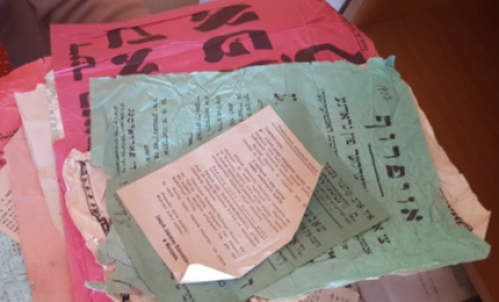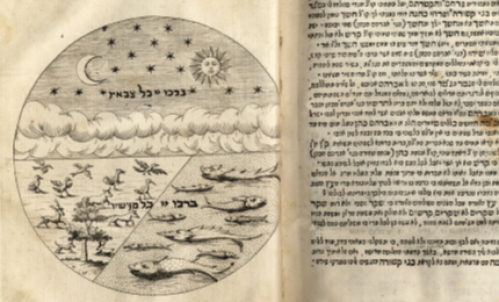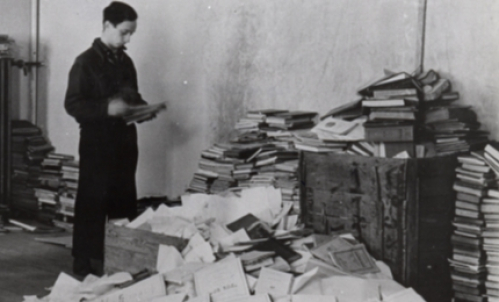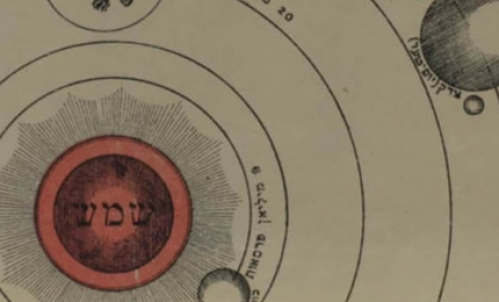Key Word "Shtetl": Interview with Jeffrey Shandler
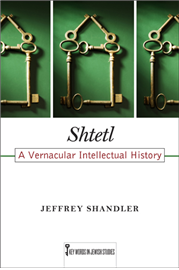
In January 2014, Rutgers University Press published Shtetl: A Vernacular Intellectual History by Jeffrey Shandler. It traces the history of writing about the shtetl to demonstrate how the Yiddish word for “town” emerged as a key word in Jewish culture and studies. Today, the shtetl is regarded in public culture as the paradigm of a bygone traditional Jewish communal life. At the same time, the shtetl is attracting growing scholarly interest, as historians, social scientists, literary critics, and others seek to understand both the complex reality of Jewish life in provincial towns and the nature of its wide-ranging remembrance.
Jeffrey Shandler is a professor of Jewish studies at Rutgers University. He is the author of While America Watches: Televising the Holocaust; Adventures in Yiddishland: Postvernacular Language and Culture; and Jews, God, and Videotape: Religion and Media in America.
He was interviewed by Yedies Editor, Roberta Newman.
Buy the book.
RN: I want to start off by asking, what fascinated you about the word “shtetl” to the point that you decided to think deeply about the word and write an entire book about it? Why did you pick this particular word?
JS: I was approached by one of the editors of Rutgers University Press’s Key Words in Jewish Studies Series who asked if there was a key word I’d like to write about. And I said, “Well, how about ‘shtetl’?” Because I’d been thinking that I would like to write something about post-World War II practices of remembering the East European Jewish past, about which I’ve written, here and there.
And so when I said, “How about ‘shtetl’?” the editor looked at me funny. She said, “Really? Shtetl?” As if to say, that’s not a key word in Jewish Studies. So I realized, okay, I have to make my case. I went and wrote a proposal [and Rutgers University Press loved it]. And writing the book, I realized that this very issue was something that needed to be addressed. Why doesn’t “shtetl” seem self-evident as a key word in Jewish Studies? It’s partly because it’s a word about something very ordinary. This is a case study in how the ordinary gets studied in the field of Jewish Studies. In fact, studying the ordinary is a real challenge in this field. When you look at the history of modern Jewish Studies, they’re not interested in the ordinary, and partly they’re not interested in it because most scholars at any given time aren’t interested in it. Western scholarship tends to be about great men—always men—great events, and big places. Cities? Yes. Little towns? No. Minority populations? No. Ordinary people doing ordinary things? Who cares, right?
So the idea that this sort of thing is worthy of study isn’t generally in place. But it comes to be something that is of interest to scholars, so that by the time you get to the turn of millennium, people are writing in languages other than Yiddish about all kinds of interesting stuff in literature, history, social sciences, and linguistics. There is now a lot of work on the topic of the shtetl among scholars.
So how did we get here? And what does it tell us about changing understandings in this field about the place of the vernacular, of the ordinary, in the study of Jewish life? So these questions emerged in the course of writing the book, and were the key issues to address. What came out of it for me is not only a deeper understanding of this particular phenomenon. I also began to ask myself: what are the challenges in this field of studying ordinary people, studying daily life?
RN: Besides “vernacular,” there’s another word that plays a big part in your thesis: “post-vernacular.” Would you please define that?
JS: I wrote a book, Adventures in Yiddishland: Postvernacular Language and Culture, about what happens to Yiddish after World War II, and what I argued was that the motive engaging the language is what I call postvernacular, in which the symbolic value of the language is as important, if not more important, than its instrumental value. In other words, the fact that something is said in Yiddish or written in Yiddish is as important or even more important than what you’re actually saying or singing or writing. This is in place before World War II but really comes to the fore in the wake of the destruction of the core of Yiddish-speaking culture during the war. So this was helpful to me in thinking about a word that in Yiddish means “town.” Any town, anywhere, with anyone living in it, in any time, not inflected in any way as a Jewish town. However, when this word starts to migrate into other languages, it takes on associations of Eastern Europe; the Jewish population of the town or a town with a lot of Jews in it; often, the culture of those people; and often, life before World War II.
And so what struck me as interesting is that the scope of the word is narrowed, but the significance gets larger. “Shtetl” is a word that describes a way of life in a cultural moment, with, at the same time, a range of values. So there are people who see that as embodying something very positive—Jewish communality, piety, a thoroughly-lived Jewish life (whatever that is)—or as having very negative associations—an association with powerlessness, with living in poverty. And, of course, all of these associations are, at best, partial descriptions of an actual phenomenon, are anything but simple or consistent.
It struck me that, all right, “shtetl” is a key word in Jewish Studies, but “town” isn’t. What happened to this word so that it doesn’t get translated, but starts to accumulate these other meanings? What does this mean in Jewish culture, and then what does it wind up meaning in Jewish Studies? In Jewish Studies, using that word as a scholarly word comes very late. It comes on the heels of extensive writing—whether it’s literary writing, or memoirs, or other kinds of non-scholarly writing— that embeds “shtetl” in Jewish vocabulary, as a word carrying all these meanings. And then scholars come to it as a way of asking, well, what is that culture? What is it that this word embodies? How do we understand it? Of course, what’s key is that this really becomes a question, in an organized way, after World War II. It’s very interesting to look at what this looks like before the war, but it really winds up coming into its own after the Holocaust.
RN: Nowadays “shtetl” is almost a household word—you don’t have to be a scholar to have some notion of what it means.
JS: Or Jewish!
RN: Was there a time when the word was unfamiliar to people who didn’t speak Yiddish? When did it become a household word?
JS: In English, it’s after World War II. So for example, the first reference in The New York Times that uses the word “shtetl” is in 1952, in a review of Life is with People, a book that put “shtetl” on the map, so to speak, for a lot of readers—and not only for Jews—in an Anglophone world, especially in America, but elsewhere as well. It created a certain image that people are still struggling with, of a thoroughly Jewish, timeless, thoroughly organic, pious bubble.
Before that, it’s not that there aren’t discussions about Jewish life in these towns, but that term isn’t used. In fact, if anything, before the war you have the use of the term “ghetto” to describe a Jewish enclave, neighborhood, community anywhere—whether it was officially a ghetto like Venice or Frankfurt or Prague, or neighborhoods in New York and Chicago. Little towns in Eastern Europe were referred to as ghettos, the entire Pale of Settlement as one mega-ghetto.
“Shtetl” comes along after the war, and in English replaces the use of “ghetto.” You see this with other languages, too. Thanks to Google Books, you can actually track when all of a sudden this word starts to appear in French, German, and Russian publications. So it really is a postwar phenomenon. It has a lot to do with a shift away from Yiddish and Yiddish-speaking communities of the discussion about these towns and what they mean to Jews.
RN: That brings me to another question. Are there geographical distinctions in the way that the term “shtetl” is used today?
JS: In Eastern Europe, especially Poland, you have actual locations with the traces of Jewish life in them. You have buildings that used to be synagogues or Jewish homes or other institutions, and you have cemeteries in hundreds of towns. You don’t have people. The very small Jewish population is almost exclusively in the larger cities. But in some of these places you do have an interest in the Jewish past, which has become less fraught than it once was.
So there are now, for example, organizations that work with children to study the local prewar history of their town, in which they discover that right before the war, half the population, sometimes more, were Jews. And they, for example, might create a website or a walking tour or something like that, and this becomes part of their education about the community. So it’s very much rooted in geography.
There are tourist practices, as well, which have actually been around since before the fall of Communism. There were certain places like Tykocin, for example, which had a synagogue that was restored in the 70s, is at the center of a local tourist practice, and is a big part of a local economy.
In the United States, you don’t have the places, but you do have people. You have people who know that their parents, their grandparents, or their great-grandparents came from certain towns, and sometimes they go to Poland as tourists. They might do genealogical research or create websites based on translations of yizker bikher [memorial books] or collect photographs. They might write fiction about imagining your way back into the shtetl—and this strikes me as a distinctly North American phenomenon.
This is really interesting, because you don’t have that phenomenon in Israel. In Israel, the shtetl is much more likely to be viewed as an abject site, even for Israelis who might be very post-Zionist in their thinking, or who are looking to get beyond a classic narrative. This isn’t necessarily the rubric in which they think about alternatives. But, of course, there are a lot of scholars in Israel doing really important work on the subject of the shtetl.
RN: So the shtetl doesn’t have the same place in the popular imagination in Israel as it does in North America?
JS: Not that I’m hearing about from my colleagues who know this culture much better than I do. The big thing that happens after World War II, especially as you get further and further away, is that the engagement is less and less about the memories of people who lived in these towns before World War II, and more and more about people who are working through their imaginations. And their sources are somebody else’s conception, whether it’s a historian, or a memoirist, or a writer or a painter or a photographer, or what have you. They’re remediating something.
RN: As there are fewer and fewer people who could have possibly be old enough to have a memory of life in prewar shtetlekh, this has begun to happen more and more.
JS: Yes, of course. Those who are old enough have turned their memories into books or paintings or sculptures or photo collections, or they’ve gone back to Poland with filmmakers and they’ve made films, or they go around and talk about the town. So they turn their memories into something else, and that something else is what becomes the basis for future engagements. And—you see this even before World War II—people living in these towns are thinking about their lives in these shtetlekh in relationship to how they’re written about in literature, how they’re studied by folklorists, how they’re visited by tourists. And that shapes their own understanding of who they are.
It’s interesting to think back before World War II because World War II is the big boundary. The interwar period is so interesting because you see the beginnings of the modern scholarly turn toward the shtetl. And, of course, YIVO is really key in this. The thinking was: “Nobody else is doing this. We know that it’s important. We want to study this and document and analyze it, and also celebrate this culture.” So, we see that going on, and there is a very interesting relationship with the general public. The public is the subject of study, but it also consists of people who are trying to have a richer and more positive understanding of the culture that they live in. It’s really a remarkable phenomenon, and sadly a very brief one, in that we have this period where things are just falling into place in interesting ways, and then it’s undone.
However, there’s also a very profound sense among people writing between the wars, that in terms of the loss of a culture that once existed, the big boundary was World War I. Of course, World War I was plenty bad—we only lose track of that because World War II was even worse. For instance, Issachar Rybak does this wonderful series of drawings that’s called Shtetl, mayn khorever heym; a gedekhenish [Shtetl, my destroyed home; a remembrance], and if you say to somebody, “When do you think a work with a title like that would have been made?” the answer might be “in the wake of World War II.” But it was written in the wake of World War I.
You have ethnographers talking about how this pre-World War I culture is rapidly disappearing, and how we have to document it, we have to cope with this destabilization and loss of culture. So that’s shaping a lot of what we get from the interwar period, driven as it is by its own concerns about how to address a sense of loss—which, of course, we had to address on a much grander scale later on.
RN: Do you think the term “shtetl” is going to continue to evolve over time? Are we, in fact, at the top of an arc in this particular area of Jewish Studies?
JS: This is similar to another question I get asked a lot: “What is the future of Yiddish?” My answer for that applies to your question, as well: Expect the unexpected. For instance, if, in the early 80s you had said that Communism was going to fall and it would going open up Eastern Europe, that people were going to be visiting places and getting into archives, and Jewishness was going to have this whole different balance in these countries, I would’ve said, “Really?” Who saw that coming?
I think that Eastern Europe—Poland, Ukraine, Belarus, Lithuania, Latvia, Hungary, Romania—has a lot of potential for expansion. People are interested in trying to root a sense of the Jewish past in the Diaspora. Even Israelis, who are very loyal to their country, no longer feel that in order to demonstrate that loyalty they have to repudiate the Diaspora. So the [classical Zionist concept of negation of the Diaspora] is being completely rethought. I think you will see a growing interest in the Diaspora among Jews of East European background, including Israelis.
RN: Not to mention the possible growth of scholarship by non-Jews in Eastern Europe, who are going to examine Jewish history and culture within their own contexts.
JS: I think you already see this. When you look at what Jewish Studies looks like in Europe, the involvement of people who aren’t Jews plays a much larger role than it does in North America, where it’s not only Jews, of course, but the majority of Jewish Studies scholars are Jews. In Europe, it doesn’t play out that way.
Interview transcribed by Alix Brandwein and edited for length and clarity.
